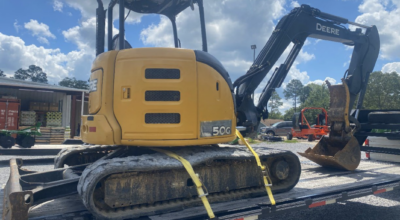August County Gardeners Extension Express
Published 4:10 pm Friday, July 28, 2023
Fall Gardening
August’s heat is the indication that it’s time to plant the fall garden. Fall gardens can be planted with the same varieties as are used in the spring. The key to having a successful fall garden is maintaining sufficient water on the young plants. I recommend gardeners use drip irrigation systems and soaker hoses to keep the plants watered. The root zone of young plants extends 2 to 3 inches deep, and likely will require daily watering to keep moist in August. As the plants mature, water 1 inch weekly.
Early August is the time to plant tomatoes, peppers, squash, sweet corn, peas and beans. Plant things in the cabbage family from about August 20 to the middle of September. Cabbage, broccoli, and cauliflower are actually easier to grow in the fall because temperatures have moderated by the time they are ready to produce fruit.
Before planting fall gardens, treat any weed problems that existed in the summer. Find a herbicide labeled for the crops that will be planted. For home gardens, I recommend the herbicide trifluralin, which is sold under such brand names as Treflan, Preen, and Trilin.
Insects are more of a problem in the fall than in the spring, so be vigilant. When you see them, control them by whatever method you deem appropriate.
Wild animals become more of a problem with fall gardens as other plants tend to be drying up and going to seed. A well -watered garden of young plants offers a tempting meal. Electric fencing and protective netting can help keep the wild animals from eating your plants.
Once established, fall gardens typically can grow and produce until the first frost, which in Mississippi ranges from October to December. Winter gardens, usually planted in different types of greens and English peas, can be planted when the fall garden is finished.
Basic Backyard Wildlife Habitat
Creating your backyard habitat can be very easy once you understand that wildlife, just like people, have three basic needs. These needs food, water, and cover promote use and provide the lifecycle needs of wildlife. A successful backyard habitat must include all three needs. It takes only a small investment of time to make your yard or garden “wildlife friendly” by adding these essentials. You can provide food in two ways, artificial feeding
– bird feeders, squirrel feeders, etc. and the preferred, natural vegetation
– planting a variety of native trees, shrubs, grasses, and flowering plants that provide nuts, seeds, nectar, fruit, and other sources of nourishment. It provides a seasonal approach that is enjoyable from a gardening and recreational wildlife standpoint. This will encourage a wider range of creatures already used to using these plants. Using natural vegetation, compared to providing artificial feed, is less costly over time and is easier to maintain. Remember, including plants that provide foraging opportunities in the winter offers an almost year-round supply of food. Providing water for both drinking and bathing is vital to wildlife. You can include it by having birdbaths, drippers, or small ponds. Garden ponds that are large enough to include water animals (fish, frogs, toads, salamanders, snails) as well as water plants add beneficial elements that complement most backyard habitat settings. Surrounding the pond with plants adds to the attraction for wildlife. Be sure the water source is dependable year -round. Nesting and shelter areas where wildlife are protected from the weather and predators are essential. Providing a diversity of plant material that includes evergreen and deciduous trees, vines, shrubs, herbaceous plants, grasses, and ground covers lets wildlife select the right areas for their feeding, nesting, and shelter needs. Ideal habitats include plants of various sizes, densities, and types. Evergreens are particularly valuable for winter cover. Grouping plants close to sources of food and water provides the cover wildlife need to feel safe while feeding or drinking. Of course, proper selection of plants includes those that provide food as well as good cover and nesting. Living plants are only one way to provide shelter and nesting areas. Using bat houses, bird houses, toad houses, and other artificial shelters is an easy way to meet this basic need.
Garden Calendar: August
Prepare
• Plan beds for bulbs. Order Tulips, Hyacinths, Dutch Iris, Daffodils, Narcissus, and Amaryllis. • Prepare beds for October planting by adding compost or leaf mold.
Plant
• Plant Daylilies in a sunny location. They will be well established before winter. • Divide and transplant Louisiana Iris, Easter Lily, Canna, Liriope, Ajuga, and Shasta Daisy. • Plant cool season vegetables: Broccoli, Cauliflower, Brussels Sprouts, Cabbage, Spinach, Potatoes, Lettuce, Carrots, Beets, Radishes, and English Peas. Plant warm season grasses: Buffalo, Bermuda, and St. Augustine.
• Mums should be planted for September bloom and fall color. • Marigolds, Asters, Zinnias, and Celosia can be planted to replace faded annuals. • Plant seeds of Calendula, Columbine, English Daisy, Forget-me-not, Pansy, Sweet William, and Violet.
Fertilize
• If acid loving plants including Azaleas, Camelias, and Gardenia show signs of chlorosis (yellowing of
leaves), a treatment of Iron Chelate should cause leaves to regain their green color.
• Feed mums with a complete fertilizer every two weeks and water thoroughly until buds show color.
Prune
• Cut back annuals, such as Impatiens and Vinca to encourage fall blooms. • Disbud Camellias, Dahlias, and Chrysanthemums to produce specimen blooms. • Continue to remove dead heads in the garden to stimulate blooming. • Cut back rose canes to 24-30 inches from ground for autumn blooms. • Remove dead and damaged wood from trees and shrubs.
Water
• Water garden deeply, but infrequently throughout the month. • Water early in the morning or in late afternoon. Water on leaves during the heat of the day can cause the
sun to burn leaves.
• Potted plants and hanging baskets need to be watered daily. • Make sure Azaleas and Camelias stay well watered, because they are forming flower buds for next year.
Miscellaneous
• Mow weekly and leave clippings on the lawn. • Turn compost pile. • Feed the birds.
In Bloom
• Ageratum, Angel’s Trumpet, Balsam, Begonia, Browallia, Caladium, Canna, Celosia, Clematis, Dahlia,
Four-o’clock, Funkia, Gladiolus, Lily, Hosta, Impatiens, Marigold, Periwinkle, Phlox, Portulaca, Rattle
Box, Salvia, Snow-on-the-Mountain, Torenia, Vinca, Pink Zephyranthes Lily, Zinnia, Althea, Butterfly Bush, Crape Myrtle, Hydrangea, Oleander, Roses, and Tamarisk.
Fall Webworms
A common question I have been receiving recently is, “webworms are killing my trees what can I do”? Fall webworms are seen all over South Mississippi this time of year. They will feed on many different trees, but pecan and persimmon are their favorite. These caterpillars normally feed inside the web where they are protected from birds and other predators during the day but at night they will venture outside the webs. Some years populations can reach high numbers and cause severe defoliation. In these cases, the nut crop can be affected that year and the following year.
Treating large trees can be difficult for people who do not have access to large air blast sprayers. Using an Air blast sprayer, a commercial grower can easily control webworms. For many of us, the trees are in a home lawn, and we don’t have access to this type of equipment. In these cases, the common thing to do is nothing. These mature trees even if severely defoliated will be able to survive without any long term problems other than the reduced nut crop for that year and the following year. If a tree is small enough to be sprayed with a handheld sprayer, you can use spinosad to control the webworms. Another option is to use a long pole to tear apart the webs exposing the caterpillars to predators.
What is this Weed?
Bahiagrass is a deep -rooted perennial adapted to a wide range of soils. Bahiagrass is most productive on sandy soils with a pH of 5.5 to 6.5. Bahiagrass is a native to South America. It was introduced to the southeastern United States primarily for forage, and erosion control. It is now frequently planted on roadsides and highway right-of-ways because it has good drought tolerance. Bahiagrass is easily identified by its Y-Shaped seed head (left). It spreads rapidly by rhizomes and stolons. It has a light green color, coarse texture and forms an open canopy. Bahiagrass is a prolific seed-producing plant.
Maintaining the health and density of your lawn is the best method for preventing a weed problem. Proper mowing height, irrigation, and fertilization of turfgrass will be the best defense against weeds. If bahiagrass becomes a problem in a turf area, it can be dug up, or an herbicide may be used. If an herbicide treatment is chosen, treatments should be timed appropriately for optimum effectiveness. Since bahiagrass is a perennial weed that also reproduces by rhizomes, post-emergent herbicides will also be necessary for improved control. Post -emergent herbicide applications should start in April when bahiagrass is small and starting to actively grow. Products containing the active ingredient metsulfuron-methyl (MSM Turf) will control
bahiagrass in Bermuda, Centipede, St. Augustine, and Zoysia lawns but, be cautious when using this product in centipede due to many centipede lawns containing a mixture with carpetgrass. Metsulfuron will also control/damage carpetgrass leaving dead spots in the lawn where carpetgrass is prevalent.
In centipede lawns, sethoxydim (Hi Yield Grass Killer) can be used to control bahiagrass but cannot be used on our other desired turf species. Imazaquin (Image 70 DG) can be used on all our desired turf species to control bahiagrass. Keep in mind, not all Image products can be used to control bahiagrass. For example, Image containing the active ingredient(s) sulfentrazone + quinclorac is not labeled for use on St. Augustine and does not list bahiagrass control on the label. Once bahiagrass weeds have been eliminated in areas of the turf, bare spots will be left behind. To prevent the invasion of new weeds in these bare spots, it is best to fill them with plugs or sprigs of the desired turfgrass. Read all label directions before applying herbicide products to the lawn. Know the limitations, timing of applications, temperature restrictions, application rates, etc. More is never better, so apply according to the label.
Lichens Are Not Killing Your Plants
Lichens are among the most fascinating of Mother Nature’s creatures. They are found in a variety of sizes, shapes, colors, and habitats. However, when these creatures invade landscape trees and shrubbery, homeowners frequently become concerned about possible damage to landscape plants.
If you remember your high school biology, you probably recall that a lichen is actually made up of two components — a fungus and an algae living in association with one another. However, the appearance is that of a single plant.
Lichens manufacture their own food and grow on soil, on rocks, and trunks and branches of trees and shrubs. They occur in several forms such as crusty gray, green, yellow, or white growths. Some are leaf-like, others resemble a tuft of horse hair hanging from branches.
Lichens are amazing creatures for other reasons as well. They frequently serve as a source of food for snails, mites, and insects. In subarctic regions, lichens are a food source for reindeer and caribou. In hard times, lichens have served as a source of food for man, such as when Washington’s troops at Valley Forge used lichens as a soup thickener. Today, lichens still serve as a source of natural dyes used in wool and other clothing materials.
In the home landscape, lichens most often appear on plants that for some reason are in a poor or declining condition. Why lichens tend to “pick -out” weak plants as preferred colonization sites is not entirely understood. But for whatever reason, such plants often support profuse lichen growth, and it’s easy to understand why home landscapers think the lichens are responsible for poor plant growth.
It’s important to realize that lichens don’t cause the plant to grow poorly, but they may indicate that something is wrong. So when your azaleas, camellias, plum or apple trees, or other landscape plants are affected by these oddities of the plant kingdom, remember it’s not the lichens that are the problem. It could be an entirely normal occurrence, since lichens also occur on healthy plants, or a signal that your plant has something else affecting it.
If you need assistance in identifying problems in the home landscape, call your local county
Extension office.
New Extension Agent in Hancock County!!
Camden Oglesby, Extension Agent
MSU-ES Hancock County
Phone: 228-467-5456
E-mail: cdo94@msstate.edu
Hello, I am the new ANR Extension Agent for Hancock County. I grew up in Petal, Mississippi where even as a kid I remember enjoying science. In high school, my grandparents helped me plant my first garden, which led to a desire to study agricultural sciences. From that passion, I studied at Mississippi State University, receiving two degrees in agronomy. During my master’s, my research focus was on corn nutrient management, where I was trained in the use of drone technology. In May, I was hired as an Extension Agent for Hancock County. I am excited to take on this new role and serve in any way I can. If you need assistance or just want to stop by to say hello, please don’t hesitate to reach out.





